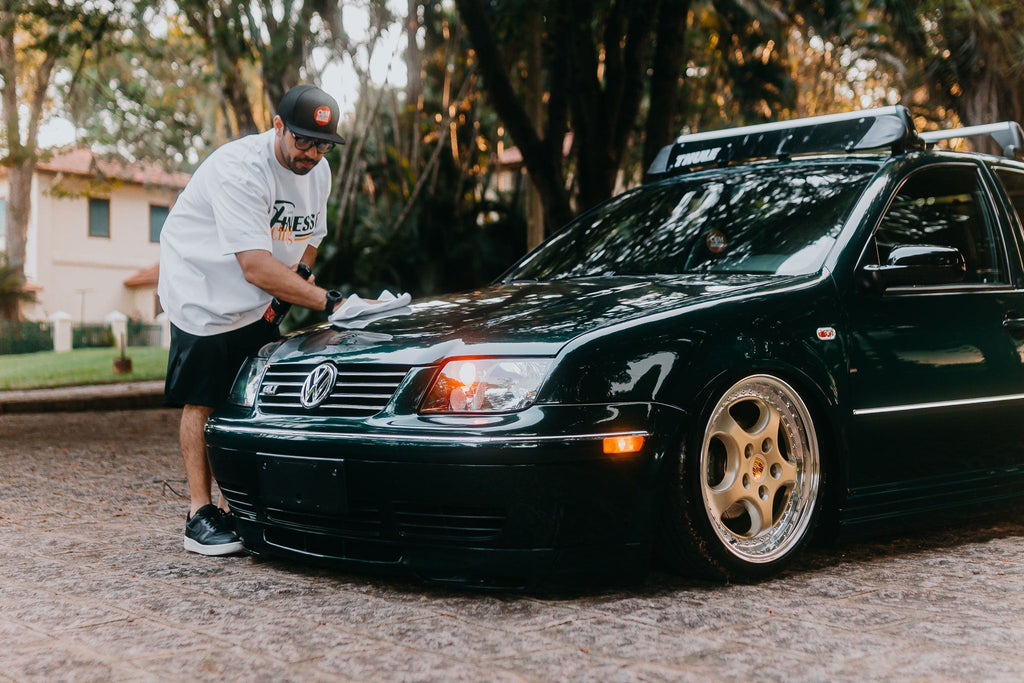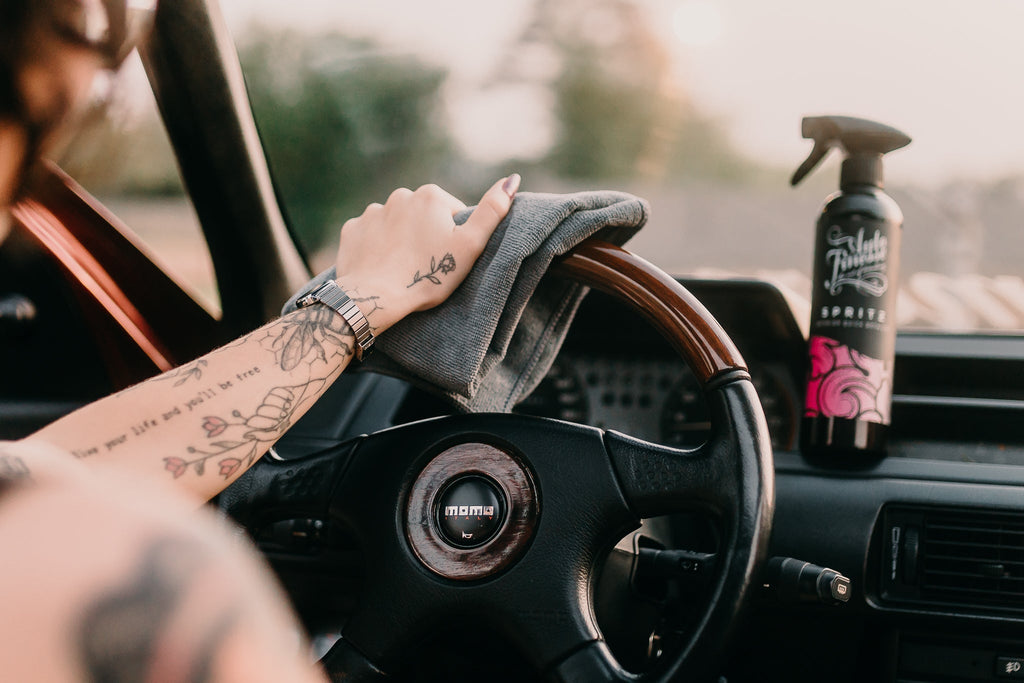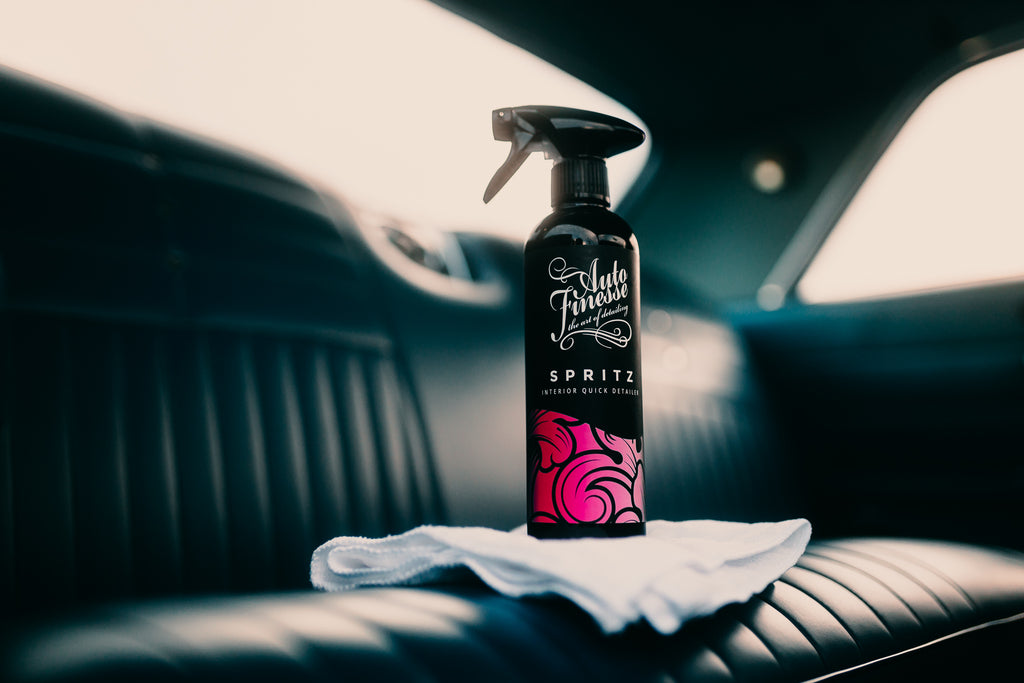Nettoyage et protection du PPF

IN THIS GUIDE:
- See how to care for a car fitted with paint protection film.
- Discover the detailing products for safe cleaning, restoration, decontamination and protection on PPF.
- See the differences between PPF, paintwork and vinyl wraps and how to tailor your detail to each.
Paint protection film is a common sight on many cars, but how do you keep it looking its best?
This is a question we’re often asked. Paintwork protection film is a popular dealer option on many high-end cars and used extensively by owners of modified cars nowadays. This means that there can be a little confusion as to the best way to safely clean, protect and keep PPF in the best possible condition. And how it’s different from paintwork or even vinyl wraps.
As always though, we have the answers so let’s delve deeper into the world of detailing cars that use paint protection film, and the best detailing products to use along the way...

What is paint protection film?
Paint protection films are designed as a transparent barrier layer that shields surfaces from acidic and abrasive contamination that may cause damage. This includes stone chips, gritty soiling, environmental contamination and bug splatter. They also protect from UV radiation and the oxidation caused by paintwork reacting with the oxygen in the air. They’re similar to a vinyl wrap, but significantly thinner, and usually made from thermoplastic urethane or polyurethane. Many even have a top layer that contains a special elastomeric polymer which gives some self-healing properties to help cut down on scratches and swirl marks.
Essentially though, PPF is a thin layer of plastic and while it may protect paintwork it’s also much softer. This means that using heavy abrasive compounds - even on self-healing PPF - will do more damage than the restoration that’s intended. PPF is also particularly sensitive to strong cleaning chemicals and solvents, including those used in many protection products.
That said, it’s also important to protect your PPF with the correct hydrophobic protection products to effectively bead up and sheet off water. PPF films aren’t particularly hydrophobic and, because dirty water and grime can stick, without adequate protection they may need more frequent cleaning than the rest of the car to stop the grime from bonding or becoming permanently engrained.

Where do they apply PPF?
Many cars, even older cars, come with a little PPF as standard. These will usually be reserved to areas that tend to suffer from stone chips – for this reason many manufacturers will simply call it stone chip film. The most common areas are wheel arches, front bumpers and leading bonnet edges. Manufacturers often use film to protect areas that can become damaged from constant human contact, such as the door handle recesses, door sills and the boot edge on your rear bumper. Because PPF has been around for decades now, you’ll find that on plenty of modern classics the factory PPF will have become a little tired over the years, but most can be brought back to life with the correct detailing products.
Aftermarket PPF usually comes in two forms; as a dealer option used as an upsell on high-end cars, or as an aftermarket upgrade fitted by a specialist. For the most part PPF is not limited to the areas that tend to suffer from stone chips, some companies will install PPF on every panel - or selected panes such as the bonnet, arches and bumpers - to protect from UV, grime and bug splatter.
What’s most important is to ascertain what parts of the car have been treated and tailor your detail accordingly. Although PPF is usually cleaned in the same way as sensitive paintwork, you’ll need to avoid it when polishing or when installing certain types of protection.

What cleaning products are best for PPF?
When it comes to cleaning the objective is to rid all surfaces of contamination without causing damage through abrasion, much like any other detail. As with all kinds of paintwork the key to a swirl-free wash is a combination of using the correct techniques and surface-safe products to lift away the grime safely allowing it to be removed without making contact with the surface.
But before you start there is one big difference with PPF, and it’s that you’ll need to be extra careful with your jet wash. Simply because you don’t want to go lifting any edges, or getting water under the PPF as this damages the adhesive. In the same way you’d detail a car with a vinyl wrap, it’s important to avoid the edges and merely mist your pressure washer over the panels instead of using heavy water pressure to attack the grime. In other words, let your detailing products do the job of breaking down and lifting contaminants safely, and avoid being too heavy handed when you’re rinsing them away.
The products you use for restoration and protection are important, too. So, to demonstrate all the important top tips from our professional detailers, lets draft in a high-end car with ‘part PPF’. This Porsche has PPF on the bonnet, sills, rear arches and bumpers…



Cleaning your PPF
We’ll start our detail in the same way as any other – by cleaning our wheels. This avoids cross contamination, or more specifically splashing the worst kinds of contamination, such as brake dust, heavy soiling, and road salt, on other areas of the car that you’ve already cleaned. You don’t want to clean the exterior twice, right?
The reason we’ll use our acid-free wheel cleaners - Imperial Wheel Cleaner and Revolution Wheel Soap – here is because they won’t harm PPF if they’re accidentally splashed onto the film. So, while we’ll always use these products for safe cleaning on all types of alloy wheels anyway, it’s a bonus that you don’t have to change wheel cleaning products when cleaning a car with PPF. In fact, if your expensive aftermarket wheels themselves are protected with PPF – it’s rare but not unheard-of - you can still use these products to clean them effectively without causing any damage.
Clean your wheels as usual and be sure to rinse down and away from the bodywork.






Now we can move onto cleaning the exterior, including the bits with PPF. The good news here is that, as long as you use the correct, surface-safe products, there’s no need to target the paintwork, glass, trim and PPF separately. It can all be cleaned together.
First, we perform a professional 2-stage pre-wash to rid all surfaces of heavy grit and grime that may damage the more sensitive surfaces - particularly paintwork and ppf - if you drag them across the bodywork in your contact wash.
After a light rinse down, simply to remove any loose grime and let our cleaning products get to work where they’re most needed, we’ll use Citrus Power Bug & Grime Remover as our pre-cleaner to break down larger particle grime. It’s a quick and simple spray-on and rinse-off job here. Citrus Power quickly lifts and encapsulates the grime, allowing you to rinse it away safely.
Next, we’ll apply Avalanche Snow Foam with our Snow Foam Lance and let it linger for as long as possible (without drying) and rinse it away to remove smaller particle bonded contamination. Avalanche also works its way into panel gaps and recesses to clean those out, too.
What’s most significant with these two pre-wash products here, is they’re surface-safe, surfactant-based cleaners. Their job is to pull contamination from surfaces and surround them safely in the solution. When you rinse away these cleaning agents, essentially, you’re also rinsing away the grime trapped in them without it being allowed to abrade the surface underneath. And all this without having to make physical contact with the car. This is what makes them safe for use on all exterior surfaces, including the most sensitive paintwork and PPF.








Now it’s safe to perform our contact wash to remove any remaining small particle grime. But even here we’ll use a few safety precautions to ensure we’re cleaning as safely as possible. Again, what’s most important is that we’ll be using a surfactant-based cleaner to safely lift and encapsulate any grime, something as vital for PPF as it is for the rest of the paintwork.
Lather Car Shampoo is our choice of cleaning agent for a couple of good reasons. First, as well as using the advanced surfactants to safely clean, it also contains special lubricants to lubricate any sharp particles, allowing them to slip safely over surfaces. It’s also classed as a pure cleaner, meaning it’s free of waxes, shining agents and coatings, so it won’t leave anything behind on surfaces to bond with your PPF after cleaning.
Just a capful or two in your wash bucket is enough for plenty of deep-cleaning suds.










Lather Car Shampoo is a powerful blend of advanced surfactants and highly-concentrated lubricants, designed to make your contact wash easier - and safer - than... See product details More
Speaking of buckets, as always we’ll be using two – one for our Lather Car Shampoo, one for our clean water to rinse out our wash media after each pass. Again, this is an important safety precaution because it significantly cuts down on the chance of any grit and grime being transferred from the bucket and back on the car.
Our professional 20L Detailing Buckets, and the 16L Mini Detailing Buckets we’re using here, also come complete with grit guards to make sure that any stray heavy particles that have sunk to the bottom can’t be picked back up again. The large water capacity also cuts down on grime recirculation in the water itself.
In other words, there’s a science to detailing buckets and how you utilise them, so always choose pro-grade kit, and always use two for every contact wash.

Finally, our wash media, that’s important for cleaning sensitive surfaces, too. The idea of using a professional Wash Mitt, or our Plush Microfibre Wash Pad, is that they’re designed to glide over surfaces freely. Unlike a sponge which will push the grime around, lambswool or microfibre wash media actively lifts grime, locking it away deep in the pile and away from the surfaces. It’ll hold on to any harmful particles until they’re rinsed out in the bucket. A small but essential safety precaution for the ultimate swirl-free wash.
When we carry out our contact wash we start on the cleaner areas and finish with the dirtier areas. Using this targeted method – starting with the roof, windows and upper-sides, then tackling the bonnet and front bumper, and finishing with the lower sides and rear end - prevents dragging grime from more soiled areas to cleaner areas.
When cleaning the most sensitive areas, such as paintwork and PPF, keep your wash media as soapy as possible and glide over surfaces lightly in straight lines to further cut down on the risk of inflicting swirls. You don’t need to physically scrub, let the combination of your wash mitt and shampoo do all the work.





After our wash we always dry, this is not only important on paintwork and glass, but arguably even more vital on PPF. The reason we always dry our cars is that tap water contains all sorts on mineral impurities. When your rinse water is allowed to dry naturally it leaves these minerals behind, and that’s what causes water marks. It’s also one of the reasons we never wash a car in direct sunlight, or when it’s still hot – the water will simply dry quicker. In many cases water marks can be polished out of paintwork, but you always want to avoid polishing PPF. But it’s far easier to remove these impurities while they’re still in the water, simply by absorbing them with a super-soft, ultra-absorbent drying towel like our Aqua Deluxe or Silk Dying Towel. Simply glide your towel over the surface and it’s problem solved.
It's worth remembering too that, as we said, PPF doesn’t have great hydrophobic properties when it’s not fully protected. This means that water will cling rather than run off, so it’s best to mop it up quickly before it gets the chance to dry out.

Spot Decontamination
We all know that sticky residues, such as road tar and rubber marks, can be difficult to remove by washing alone. This is particularly on cars, much like this one, that are often used on track days.
This is where decontaminating PPF differs to paintwork where we’d use a heavy-duty solvent like ObliTARate Tar & Glue Remover to melt away the contamination. For PPF we’d switch to Crystal Glass Cleaner which is extremely powerful but a far milder blend of distilled, fast-flashing solvents. It works in the same way to chemically dissolve the sticky contamination, but without softening the surface of the film or damaging the adhesive. A quick spritz and a wipe with a clean microfibre Work Cloth is all you need here.



Restoring PPF
Sometimes your PPF may need freshening up with a little light restoration. In a similar way to swirly paintwork, when PPF fades or picks up scratches and swirl marks, it reflects light in different directions, making it appear dull and shallow. With PPF in particular, it will also block the view of the paint underneath. But you can use Tripple All-in-One Polish to bring your faded PPF back to life with a whole load of gloss, and plenty of depth.
While Tripple is a product that uses abrasives, these advanced diminishing abrasives are extremely light and easy to break down by hand. So, while we’d never recommend a heavy compound and machine polisher on PPF, Tripple is suitable because it won’t damage the relatively thin layer of urethane. Tripple also contains deep-cleaning solvents to clear away oxidation, so essentially you can deep-clean and hand polish on a molecular level, and that’s ideal for freshening up small areas of tired PPF.
We recommend taking on a small area at a time, applying a small amount of Tripple with a Polish Pad or Microfibre Applicator. Let the product haze and then wipe away any residue, before turning your Work Cloth and buffing to a high shine. Quick, simple and effective.












Discover the ultimate car polish with Tripple All-In-One Car Polish, designed to deliver outstanding results in record time. This advanced polishing compound is... See product details More
Protecting Your PPF
The easiest way to get long term protection for your PPF, while installing plenty of shine and hydrophobic performance, is using Graphene Liquid Filler Wax. The great thing about this next-generation sealant is that it you get 12-months of protection, and it’s just as easy to use on your paintwork, too. In other words, you don’t have to change products just for the PPF areas, and you’ll get the same water beading and easy-clean properties over the whole car.
What makes Graphene special is that, as the name would suggest, it contains graphene. This is a form of carbon that’s harder than steel and more flexible than rubber on molecular level. It also bonds to surfaces to create a hard layer that’s impermeable to grime and water, along with being resistant to cleaning chemicals, UV and even abrasion. This makes it ideal for preventing your PPF from picking up scratches and swirls, and because it stops grime from sticking, keep your car cleaner for longer.
Just a few drops on a Polish Pad or Foam Applicator is enough for any large panel. Simply apply, immediately remove any residue with your Work Cloth (there’s no curing time needed) and then buff to a high shine. A year of protection in one quick and simple application. You can also top up the gloss and protection after any routine maintenance, too.












An advanced liquid paintwork sealant developed to add extreme gloss and durable, ultra-hydrophobic protection that lasts for 6 to 8-months, Graphene Filler Li... See product details More
And that’s our top tips for cleaning, restoring and protecting any car with paint protection film.
For more top detailing guides, including professional tips and tricks, check out the the Guides Section Of Our Blog.















































